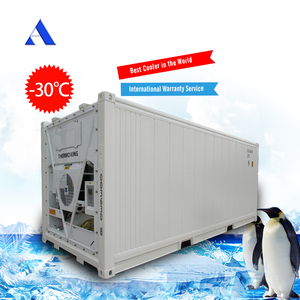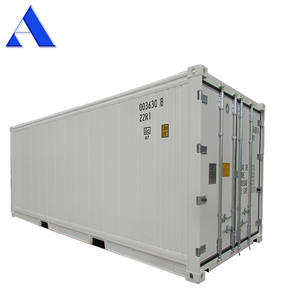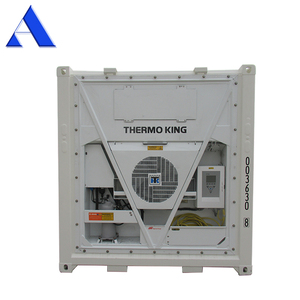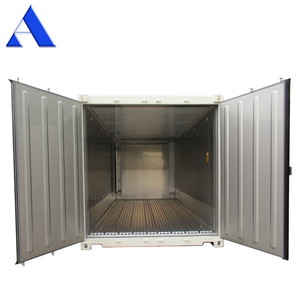
All categories
Featured selections
Trade Assurance
Buyer Central
Help Center
Get the app
Become a supplier

(932 products available)



















































Freezer containers are available in various sizes suitable for different businesses. The 20 feet freezer container is one of the most popular sizes because it offers a large storage capacity while still being manageable and portable. Here are the different types of 20-foot freezer containers.
Reefer containers
These are refrigerated containers that have freezers and can transport cargo over long distances. They are designed to maintain specific temperatures for perishable goods like fruits, vegetables, fish, meat, dairy products, and pharmaceuticals. 20-foot refrigerated containers can either be pre-trip inspected or non-pre-trip inspected. The pre-trip inspected containers have been inspected for any damage and cleaned, while the non-pre-trip inspected containers have not been inspected.
Shipping containers
These are containers designed for shipping and are used as freezer containers for goods that need to be frozen. Like reefer containers, they are designed to maintain specific temperatures for various types of cargo during transport.
Cold storage containers
These are portable storage containers that are refrigerated and are used for cold storage. They are used when there is a lack of space to store food that is frozen or refrigerated. Cold storage containers are useful for various industries, including supermarkets, food processing, and healthcare, where temperature control is critical for inventory management.
The specifications of 20-foot freezer containers may vary depending on the manufacturer and model. However, here are some common specifications for these containers.
Size and Capacity
20 feet freezer containers have a length of about 20 feet, a width of 8 feet, and a height of 8.6 feet. They hold up to 10 pallets or 20 pallet goods. The total volume of a 20 feet freezer container is about 33 cubic meters, and its maximum cargo capacity is about 30,000 kg.
Temperature Control
The 20-foot freezer container has a refrigeration unit that can maintain a constant temperature of -18 °C to -20 °C. The temperature can be adjusted through the control panel. Some models may also have temperature alarms and monitoring systems.
Power Supply
These containers can be powered by various sources, such as 220V/380V/440V electricity, which is common in ports and terminals. They can also use 50Hz/60Hz frequency power and have a backup battery for emergency use.
Insulation
The walls, floors, and roofs of the 20-foot freezer container are insulated with high-quality polyurethane foam, with a thickness of about 10 cm; thus, the heat transfer coefficient is low. The insulation can reduce the energy consumption of the refrigeration unit and keep the internal temperature stable.
Construction Material
20 feet freezer containers are usually made of high-strength steel or aluminum alloy. These materials have good corrosion resistance and durability, which can withstand harsh environments and extreme weather conditions.
Access and Security
These containers have an access door at one end and a lock system that provides easy access and security. Some models may also have a second door for quick loading and unloading.
Ventilation
The 20-foot freezer container has ventilation holes that allow airflow inside. This ventilation helps maintain the temperature inside the container and prevents the formation of frost and ice.
Monitoring and Control
Freezer containers have monitoring and control systems, such as temperature displays, alarm systems, and control panels. These systems allow users to monitor and control the temperature and other parameters inside the container in real time.
Regular maintenance is essential to ensure that the 20-foot freezer container operates efficiently and reliably. Here are some maintenance tips:
Cleaning
Freezer containers should be cleaned regularly, both inside and outside. Pay attention to the refrigeration unit, ventilation holes, and other essential parts to avoid dust, dirt, and ice accumulation, which may affect the container's performance.
Temperature Checks
The temperature inside and outside the freezer container should be checked regularly using temperature measuring devices. Ensure that the refrigeration unit operates correctly and that the temperature inside the container remains stable.
Refrigeration Unit Inspection
The refrigeration unit of the 20-foot freezer container should be inspected regularly, including checking the coolant level, the fan's operation, and the compressor's performance. If any issues or abnormalities are detected, they must be addressed immediately.
Door and Seal Inspection
The doors and seals of the freezer container should be inspected to ensure they are tight and without gaps. If any damage or wear is found, replace the seals or repair the doors to prevent cold air leakage.
Ventilation Hole Inspection
The ventilation holes of the 20-foot freezer container should be inspected to ensure they are unobstructed and without blockages. Blocked ventilation holes may affect the airflow inside the container and cause temperature fluctuations.
Electrical System Inspection
The electrical system of the freezer container should be inspected regularly, including checking the power supply, cables, connectors, and control panel. Ensure that the electrical system operates correctly and that there are no issues such as loose connections or damage.
Annual Professional Inspection
It is recommended that users invite professional personnel to inspect and maintain the freezer container at least once a year. Professionals can check the refrigeration unit, electrical system, and other essential parts' performance and provide necessary repairs and maintenance services.
When it comes to selecting a 20-foot freezer container, whether it's for sale or rental, there are several important factors to consider. Here are some tips:
Freezer replacement parts for 20-foot containers are easy to find, and the installation process is rather straightforward. The process depends on the specific part of the container that needs to be replaced. Below are some of the common replacements and how to do them.
Replacing a compressor unit:
First and foremost, it is important to read the manufacturer's manual to understand the system's refrigeration layout. Switch off the power supply to the compressor unit.
Next, remove the access panel to the compressor and disconnect the electrical wiring.
After that, remove the compressor mounts and drain the refrigerant following safety and environmental regulations.
Now, install the new compressor by aligning it with the mounts and securing them.
Reconnect the electrical wiring and replace the access panel. Finally, power up the system and check for any leaks or unusual noises.
Replacing the temperature control unit:
To replace this unit, turn off the power supply to the control unit. Then, disconnect the electrical wiring from the control unit and remove the temperature control unit from its mounting.
After that, install the new control unit and connect it to the electrical wiring. Finally, power up the unit and calibrate the controls to the desired temperature.
Insulation replacement:
Drain any refrigerant and remove the interior lining. After that, take out the damaged insulation and clean the area. Now, install the new insulation panels and ensure there are no gaps. Then, reinstall the interior lining and inspect for leaks.
Door seal replacement:
Remove the old door seal by prying it loose. Clean the area and install the new seal by aligning it properly and ensuring a tight fit.
Replacing a fan motor:
Disconnect the electrical supply to the fan motor. Then, remove the motor from its mounting and disconnect it from the fan blades.
Now, install the new motor and connect it to the fan blades. Finally, power up the system and check the fan's operation.
Q1: How many pallets fit in a 20-foot freezer?
A1: The number of pallets that can fit in a 20-foot freezer container depends on the pallet size. For standard Euro pallets, which measure 120 cm x 80 cm, about 10 pallets can fit. However, if using smaller pallets like the Chep Australia pallet (which is 1165 mm x 1165 mm), only 5 pallets will fit. It's essential to calculate based on the specific pallet dimensions to determine the exact capacity.
Q2: What is the maximum weight limit for a 20-foot freezer container?
A2: The maximum weight limit for a 20-foot freezer container is generally around 30,000 kg (66,138 lbs). This includes the container's tare weight (which is about 3,000 kg) and the cargo weight. Exceeding this limit can pose safety risks and lead to legal penalties for overweight loads.
Q3: Can a 20-foot freezer container be used for non-frozen goods?
A3: Yes, a 20-foot freezer container can be set for goods that require temperature control but not freezing. The temperature can be adjusted to suit the requirements, ensuring the products remain fresh without being frozen.
Q4: Is it possible to stack containers for shipping?
A4: Yes, 20-foot freezer containers can be stacked for shipping. They are designed with corner posts that allow for secure stacking. However, it's crucial to follow the manufacturer's guidelines and ensure proper weight distribution for safety during transit.
Q5: What is the difference between a refrigerated container and a freezer container?
A5: A refrigerated container is used to maintain temperatures above freezing for perishable goods, while a freezer container is designed to store goods at freezing temperatures. The temperature settings differentiate them, but both serve to preserve cargo during transport.